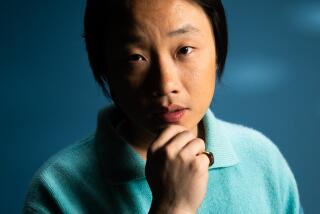There she is, Miss Chinatown
JUST WHEN I thought this columnist gig wouldn’t pay off, I got a call from Kenny Yee, L.A.’s “Noodle King.” Kenny is the president of Wing Hing Noodles, a local, family-owned firm, as well as the head of the Chinese Chamber of Commerce of Los Angeles. He called to ask me to be a judge at this year’s Miss Los Angeles Chinatown Pageant. Who was I to turn him down?
Actually, for a week I went around telling anyone who would listen that I was going to be a pageant judge. I got a lot of laughs. Not surprisingly, my male friends mostly shared my glee, while my female friends and colleagues had a more complex reaction. The 21-year-old UCLA graduate student who helps me with research, a self-described radical, asked me point blank what exactly made me qualified to judge these young women. My friend Marie simply said: “I can’t believe you’re going to do it.”
There is little doubt that over the last generation, the nation’s blockbuster beauty pageants have become painfully anachronistic. On the very night of the Miss Chinatown pageant in L.A., producers of the Miss America contest in Las Vegas were trying desperately to regain some of their event’s lost luster a year after ABC dumped the program because of poor ratings.
Once upon a time, tens of millions of Americans tuned in to the Miss America pageant to witness the selection of the embodiment of the nation’s collective idea of womanhood. But over the last four decades, a combination of feminist critique, the omnipresence of sex on television and, most recently, the rise of various kinds of talent shows on TV have undermined its popularity.
At the same time, however, immigrant communities everywhere have been reviving the old-fashioned beauty pageant as a way to celebrate both their heritage and their assimilation. Typically in these contests, judges are instructed to identify the ethnic ideal as much as a feminine one. What does that mean? Well, the word “beauty” isn’t even part of the event title in Chinatown these days (OK, there is a swimsuit competition). The criteria are things like intelligence, poise and sincerity.
And in contrast to the Miss America contest, which seems to exalt a rather stale view of womanhood, ethnic pageants generally seek to capture and celebrate an ever-evolving combination of old-world continuity and American progress. In other words, in these pageants, the definition of what it means to be Chinese or Indian or Salvadoran in the United States is dynamic and continues to expand over time.
At least for those who support such events, the queen and her court are goodwill ambassadors from one’s ethnic group to the broader society. Miss Chinatown, Taiwanese-born Melody Chi Cheng, a sophomore at UC Irvine, will spend a year meeting and greeting at more than 100 events across the city, all to earn a Piaget watch and other prizes.
The oldest ethnic pageants in L.A., Miss Chinatown (starting in 1963) and Miss Nisei Week in Little Tokyo (dating from 1935), no longer even require that contestants be Chinese or Japanese on both sides of their family tree. Recognizing the high incidence of ethnic and racial intermarriage, pageant organizers have determined that contestants only had to be a quarter Chinese or half Japanese to enter, respectively.
Since the early 1980s, the crowning of mixed-race contestants as Miss Nisei Week has sparked debate over the shared definition of what it means to be Japanese in America. Ultimately, however, the acceptance of racially mixed participants can’t help but shift an audience’s notions of its cultural, ethnic and aesthetic ideals. It is all the more interesting that at this year’s Miss Chinatown pageant, only three of the seven judges were Chinese American.
In one way or another, this year’s contestants were judged on how well they balanced their hyphenated selves. In addition to having to parade on stage in that one-piece bathing suit, the women also wore a traditional Chinese cheongsam. While knowledge of Chinese was a plus, it wasn’t required. Furthermore, each contestant had to answer an insanely difficult question on current events. In her personal interview, Cheng exuded a suburban Southern California insouciance and a refreshing articulateness about the need to both rebel against and adhere to tradition.
At the end of the night, two of the five members of this year’s Miss Chinatown court were racially mixed. The second princess, Kaye Ponnusamy, is half East Indian; the third princess, Angela Chao Roberson, is half African American. Kenny Yee didn’t hide his pleasure with the outcome. “It reflects well on us that we still embrace the fact that we’re Chinese even as we’re mixing,” he said.
As for me, the night didn’t wind up being as carefree as I foolishly thought it would be. The judges took their job seriously, and I was engulfed in a dizzying matrix of numbers on my score sheets. As for my feminist friends, I’m telling them that for all the objectification inherent in a pageant, it pales compared with the kind of titillation one sees nightly on television. So if the organizers of Miss Koreatown or Miss Nayarit are looking for a judge, I’m available.






